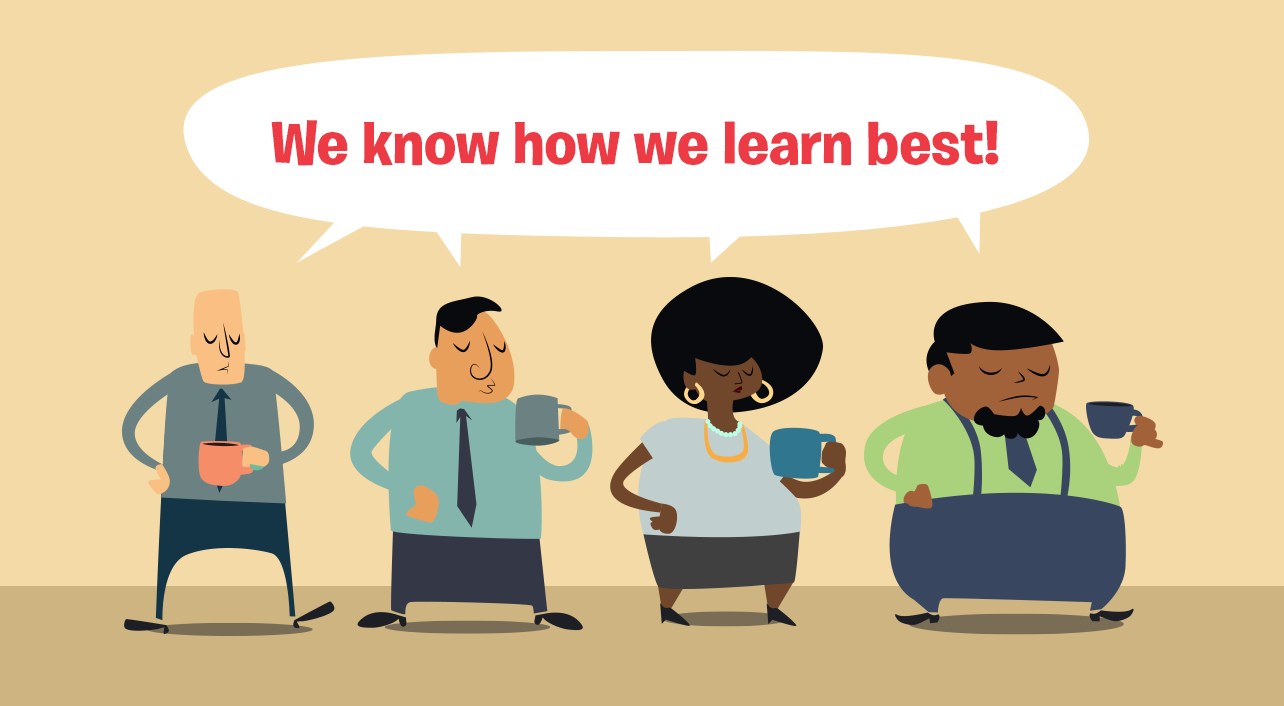- rli
- Blog post
When it comes to learning, do learners really know best?
Engaged employees can probably tell you what they want to learn and why it will benefit their career. They likely also have thoughts on how they want to learn it.
But should you listen?
Multiple studies have shown that when people have strong opinions when they’re asked how they learn best. Almost always, those opinions happen to be wrong. When it comes to learning, we’re terrible judges of what works and what doesn’t. Especially for ourselves.
And as a recent study out of Harvard demonstrates, listening to learners’ preferences could be significantly detrimental to workplace learning.
The research
Researchers at Harvard wanted to see if learners’ perception of learning matched with their actual learning. To explore this question, they ran an experiment in a real-world physics course.
For the first 11 weeks of the course, students were taught through a traditional lecture from an experienced professor. From weeks 12 to 15, however, the instruction changed. Classes were randomly assigned either to stick with the traditional lecture or receive instruction through “active learning” techniques.
Active learning techniques are typically activities that encourage learners to delve into the material and think critically. Some commonly used activities are group discussions, problem solving, taking quizzes and role playing. The purpose is for learners to grapple with the new information and apply it in a real-world context.
In the Harvard study, the “active learning” classes were asked to break into small groups and work together on solving a physics problem instead of learning the solution through a lecture.
At the end of each class, all students were given a brief questionnaire that asked how much they agreed or disagreed with certain statements — such as: “I feel like I learned a great deal” and “I wish all my physics courses were taught this way.” They were also given a short quiz to measure their understanding of that day’s class material.
Upon the course’s conclusion, the researchers’ analysis found two major takeaways: The learners reported enjoying the lecture-based classes significantly more, but scored significantly higher on the quizzes after the active learning classes. In fact, students scored approximately 10 percent higher on the end-of-class quizzes after an active learning experience.
“A great lecture can get students to feel like they are learning a lot,” the head researcher said, but “actual learning and feeling of learning were strongly anti-correlated.”
Translation: What learners think works and what actually works are two very different things.
Why are we poor judges of our own learning?
Other studies have shown that we’re not good at judging our own learning. But why? The research suggests a couple of reasons.
Learners tend to prefer learning experiences that are comfortable. A passive learning experience, like watching an e-learning video or listening to lecture, is a comfortable way to absorb information. And that’s fine for the initial learning experience. But to get new information to stick long-term, effort and discomfort play a role.
“Deep learning is hard work,” the head researcher said. “The effort involved… can be misinterpreted as a sign of poor learning.”
Another reason is that people don’t like to make mistakes or risk failure. And many effective learning experiences — whether they are quizzes or group discussions or active coaching with a manager — result in mistakes or doing something wrong. The key here is that making mistakes is often vital to the learning process. It’s how we clear up misconceptions and course correct when we use the wrong strategy.
So it’s crucial for workplace learning programs to stress to learners that making mistakes is a natural part of learning and shouldn’t be feared or avoided.
Takeaways
Now, this research doesn’t suggest that “passive” learning content — such as, oh, a well-crafted micro-learning video — doesn’t have value. What it does suggest is that it’s just the starting point. You have to use what you’re learning.
Here are the primary takeaways from the research that you can apply in your organization’s workplace learning program:
Push learners outside their comfort zone.
People will often default to what feels easy and comfortable. And when it comes to learning, “comfortable” often means “ineffective.” So while you want to listen to your learners’ feedback, remember that sometimes they won’t know what will work for them.
Learning a new skill involves taking risks and, yes, making mistakes. Struggle and failure are simply part of the learning process and, while uncomfortable at times, should be seen as a normal step on the road to understanding.
Get learners on board.
If you’re asking your learners to be vulnerable or to risk failure during the learning process, tell them why. Show them research that backs up your approach or show them a success story from within your organization. Learners will be willing to take the leap if they know it will benefit them and that they’re supported by the organization.
Here’s one example. As a result of the Harvard study, the head researcher actually changed his approach to his courses: “I show my students the data from this study on the first day of class to help them appreciate the importance of their own involvement in active learning.” Ever since, learners’ grades and their evaluation of the course have gone up.
Source
Deslauriers, L., et al. (2019). Measuring actual learning versus feeling of learning in response to being actively engaged in the classroom. Proceedings of the National Academy of Sciences. doi: 10.1073/pnas.1821936116

Get a demo of all our training features
Connect with an expert for a one-on-one demonstration of how BTS Total Access can help develop your team.



